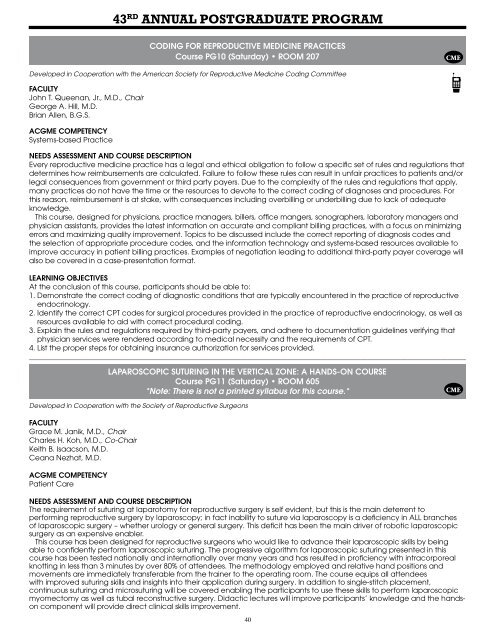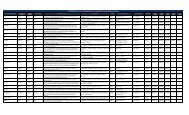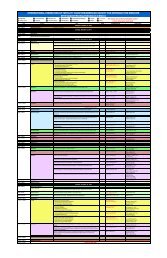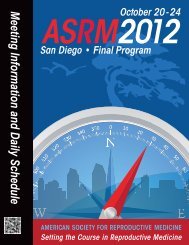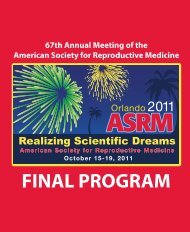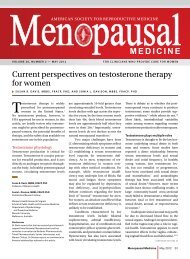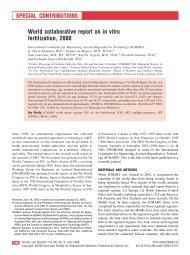scientific program • symposia - American Society for Reproductive ...
scientific program • symposia - American Society for Reproductive ...
scientific program • symposia - American Society for Reproductive ...
Create successful ePaper yourself
Turn your PDF publications into a flip-book with our unique Google optimized e-Paper software.
43 RD ANNUAL POSTGRADUATE PROGRAM<br />
Developed in Cooperation with the <strong>American</strong> <strong>Society</strong> <strong>for</strong> <strong>Reproductive</strong> Medicine Coding Committee<br />
FACULTY<br />
John T. Queenan, Jr., M.D., Chair<br />
George A. Hill, M.D.<br />
Brian Allen, B.G.S.<br />
ACGME COMPETENCY<br />
Systems-based Practice<br />
NEEDS ASSESSMENT AND COURSE DESCRIPTION<br />
Every reproductive medicine practice has a legal and ethical obligation to follow a specific set of rules and regulations that<br />
determines how reimbursements are calculated. Failure to follow these rules can result in unfair practices to patients and/or<br />
legal consequences from government or third party payers. Due to the complexity of the rules and regulations that apply,<br />
many practices do not have the time or the resources to devote to the correct coding of diagnoses and procedures. For<br />
this reason, reimbursement is at stake, with consequences including overbilling or underbilling due to lack of adequate<br />
knowledge.<br />
This course, designed <strong>for</strong> physicians, practice managers, billers, office mangers, sonographers, laboratory managers and<br />
physician assistants, provides the latest in<strong>for</strong>mation on accurate and compliant billing practices, with a focus on minimizing<br />
errors and maximizing quality improvement. Topics to be discussed include the correct reporting of diagnosis codes and<br />
the selection of appropriate procedure codes, and the in<strong>for</strong>mation technology and systems-based resources available to<br />
improve accuracy in patient billing practices. Examples of negotiation leading to additional third-party payer coverage will<br />
also be covered in a case-presentation <strong>for</strong>mat.<br />
LEARNING OBJECTIVES<br />
At the conclusion of this course, participants should be able to:<br />
1. Demonstrate the correct coding of diagnostic conditions that are typically encountered in the practice of reproductive<br />
endocrinology.<br />
2. Identify the correct CPT codes <strong>for</strong> surgical procedures provided in the practice of reproductive endocrinology, as well as<br />
resources available to aid with correct procedural coding.<br />
3. Explain the rules and regulations required by third-party payers, and adhere to documentation guidelines verifying that<br />
physician services were rendered according to medical necessity and the requirements of CPT.<br />
4. List the proper steps <strong>for</strong> obtaining insurance authorization <strong>for</strong> services provided.<br />
________________________________________________________________________________________________________________________<br />
Developed in Cooperation with the <strong>Society</strong> of <strong>Reproductive</strong> Surgeons<br />
FACULTY<br />
Grace M. Janik, M.D., Chair<br />
Charles H. Koh, M.D., Co-Chair<br />
Keith B. Isaacson, M.D.<br />
Ceana Nezhat, M.D.<br />
ACGME COMPETENCY<br />
Patient Care<br />
CODING FOR REPRODUCTIVE MEDICINE PRACTICES<br />
Course PG10 (Saturday) <strong>•</strong> ROOM 207<br />
LAPAROSCOPIC SUTURING IN THE VERTICAL ZONE: A HANDS-ON COURSE<br />
Course PG11 (Saturday) <strong>•</strong> ROOM 605<br />
*Note: There is not a printed syllabus <strong>for</strong> this course.*<br />
NEEDS ASSESSMENT AND COURSE DESCRIPTION<br />
The requirement of suturing at laparotomy <strong>for</strong> reproductive surgery is self evident, but this is the main deterrent to<br />
per<strong>for</strong>ming reproductive surgery by laparoscopy; in fact inability to suture via laparoscopy is a deficiency in ALL branches<br />
of laparoscopic surgery – whether urology or general surgery. This deficit has been the main driver of robotic laparoscopic<br />
surgery as an expensive enabler.<br />
This course has been designed <strong>for</strong> reproductive surgeons who would like to advance their laparoscopic skills by being<br />
able to confidently per<strong>for</strong>m laparoscopic suturing. The progressive algorithm <strong>for</strong> laparoscopic suturing presented in this<br />
course has been tested nationally and internationally over many years and has resulted in proficiency with intracorporeal<br />
knotting in less than 3 minutes by over 80% of attendees. The methodology employed and relative hand positions and<br />
movements are immediately transferable from the trainer to the operating room. The course equips all attendees<br />
with improved suturing skills and insights into their application during surgery. In addition to single-stitch placement,<br />
continuous suturing and microsuturing will be covered enabling the participants to use these skills to per<strong>for</strong>m laparoscopic<br />
myomectomy as well as tubal reconstructive surgery. Didactic lectures will improve participants’ knowledge and the handson<br />
component will provide direct clinical skills improvement.<br />
40<br />
CME<br />
CME


